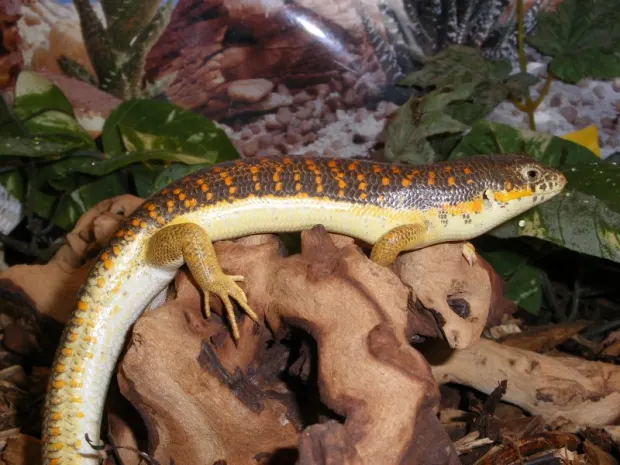
Description:
Scientific name: Eumeces schneideri
Life span: Up to 20 years
A berber skink measures around 16 inches from the tip of its nose to the tip of its tail. The underbelly of berber skinks is white, and they have stunning olive brown backs with orange spots running down their scales. They can travel quickly over sand and dig burrows thanks to their tiny snout, long tubular body, and small but strong limbs.
Native Region/Habitat
Native to northwestern Africa and Asia, berber skinks. They frequently live alone or in pairs in semi-desert regions. In general, lawfully captured Berber skinks from the Egyptian regions make up the majority of those kept in captivity. Another name for them is Schneider’s Skinks.

Behavior:
Due to their hardiness and placid personalities, these lizards make excellent low-maintenance pets. They also have beautiful appearances. They like to spend time in your hand, and if they can, they will even climb up to your head. They typically have a lot of energy and are curious tiny beings.
Care As a pet/In captivity:
Enclosure: A 3-foot vivarium will work for housing a single Berber skink, but the more room the better. These skinks explore their enclosure frequently and are rather active, especially when they are looking for food. It is essential to provide separate spaces for breeding pairs so they may hide from one another and get away if the male begins to harass the female.
Temperature: Use of a basking light on a dimming thermostat to help regulate temperature would be the most effective approach to heat the enclosure. This will also make the enclosure lighter. Because Berber skinks like a basking temperature of 35 to 40 degrees Celsius, the thermostat will need to be set very high (95-110oF). The chilly end should be between 26 and 27 oC (80 and 21 to 24 oC) at night (70-75oF).
Humidity: This species prefers humidity levels between 40% and 60%. To aid with humidity levels in the morning, we frequently lightly spray the enclosure.
Diet: Berber skinks are voracious eaters who occasionally consume pinkie mice in addition to a variety of live insects. Because they hunt and pursue after their food, scatter feeding is advised. Together with using a vitamin supplement twice a week, applying calcium dust on the insects three to four times per week will be good.
Table





